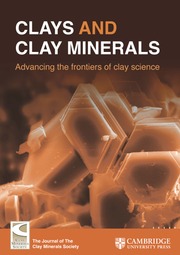Article contents
The Alteration of Some Aromatic Amino Acids and Polyhydric Phenols by Clay Minerals
Published online by Cambridge University Press: 01 July 2024
Abstract
These studies concern the catalytic activity of clays on amino acids, particularly tyrosine. Polyhydric phenols were included to help understand the tyrosine reactions.
Below pH 3, tyrosine is adsorbed on clay minerals by cation exchange. Above pH 3, oxidative degradation of tyrosine occurs, the L-isomer altering more rapidly. The rate of alteration depends upon the particular clay mineral, surface modifications such as polyphosphate treatment, heating, and the presence of copper, aluminium, and mercury. A free radical mechanism is proposed for the alteration.
Résumé
Ces recherches portent sur l’activité catalytique des argiles vis-á-vis des amino-acides, la tyrosine en particulier. Des polyphénols ont été également étudiés afin de mieux comprendre les réactions concernant la tyrosine.
En dessous de pH 3, la tyrosine est adsorbée sur les minéraux argileux par échange cationique. Au-dessus de pH 3, la dégradation par oxydation de la tyrosine survient, l’isomère L s’altérant plus rapidement. La vitesse d’altération dépend de la nature du minéral argileux, des modifications de surface telles que le traitement aux polyphosphates, du chauffage et de la présence de cuivre, d’aluminium et de mercure. Un mécanisme par radicaux libres est proposé pour expliquer l’altération.
Kurzreferat
Die Untersuchungen betreffen die katalytische Wirkung von Tonmineralen auf Aminosäuren, insbesondere Tyrosin. Mehrwertige Phenole wurden in die Untersuchungen einbezogen, um zum Verständnis der Tyrosinreaktion beizutragen.
Unterhalb pH 3 wird Tyrosin durch Kationenaustausch an Tonmineralen adsorbiert, oberhalb pH 3 findet ein oxidativer Abbau des Tyrosins statt, wobei das L-Isomer schneller umgesetzt wird. Die Abbaurate hängt von der Art des Tonminerals und von Oberflächenmodifikationen ab, wie sie durch Behandlung mit Polyphosphaten, durch Erhitzen, sowie in Gegenwart von Kupfer, Aluminium und Quecksilber entstehen. Für die Umwandlung wird ein Mechanismus vorgeschlagen, der auf der Beteiligung freier Radikale beruht.
Резюме
Эти исследования относятся к каталитической активности глин на аминокислоты, особенно на тирозин. Для лучшего понимания реакции тирозина включили многоатомные фенолы.
Ниже рН 3, тирозин катионообменом адсорбируется глинистыми минералами. Выше рН 3, происходит окислительная деградация тирозина, при чем скорее всего изменяется L-изомер. Степень изменения зависит от отдельного используемого глинистого минерала, от поверх¬ностных изменений вследствие обработки полифосфатом, от нагрева, от присутствия меди, алюминия и ртути. Полагают, что в изменениях играет роль механизм свободных радикалов.
Information
- Type
- Research Article
- Information
- Copyright
- Copyright © 1973 The Clay Minerals Society
References
- 13
- Cited by

